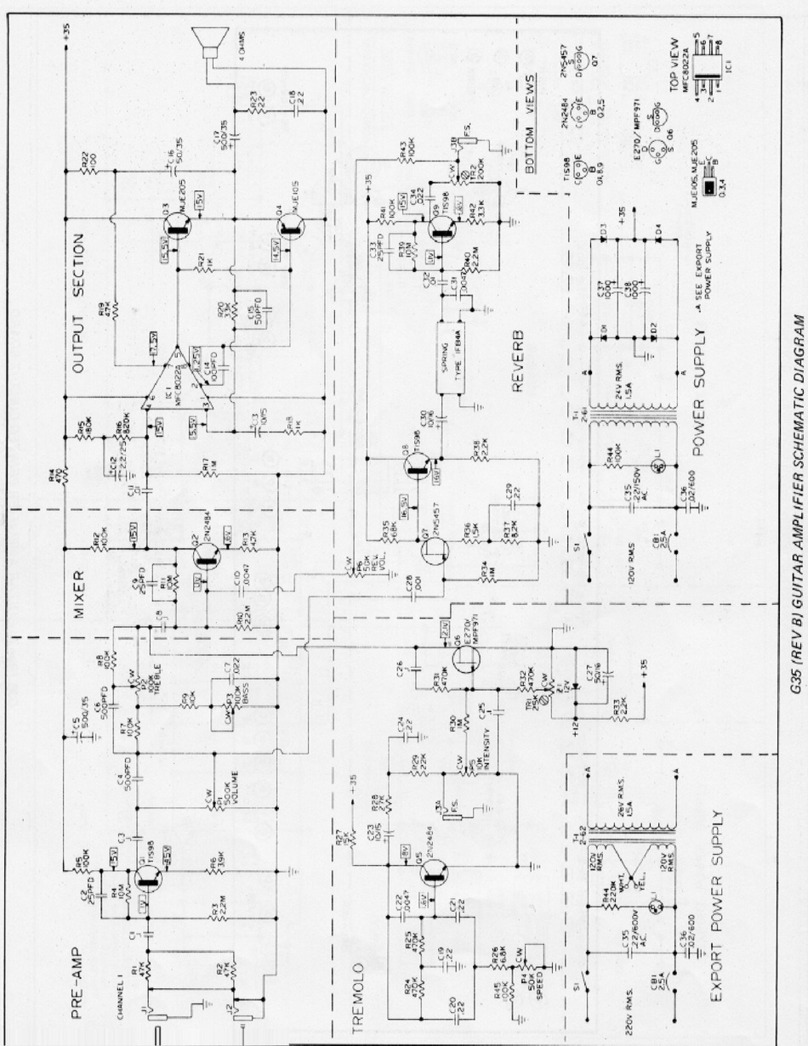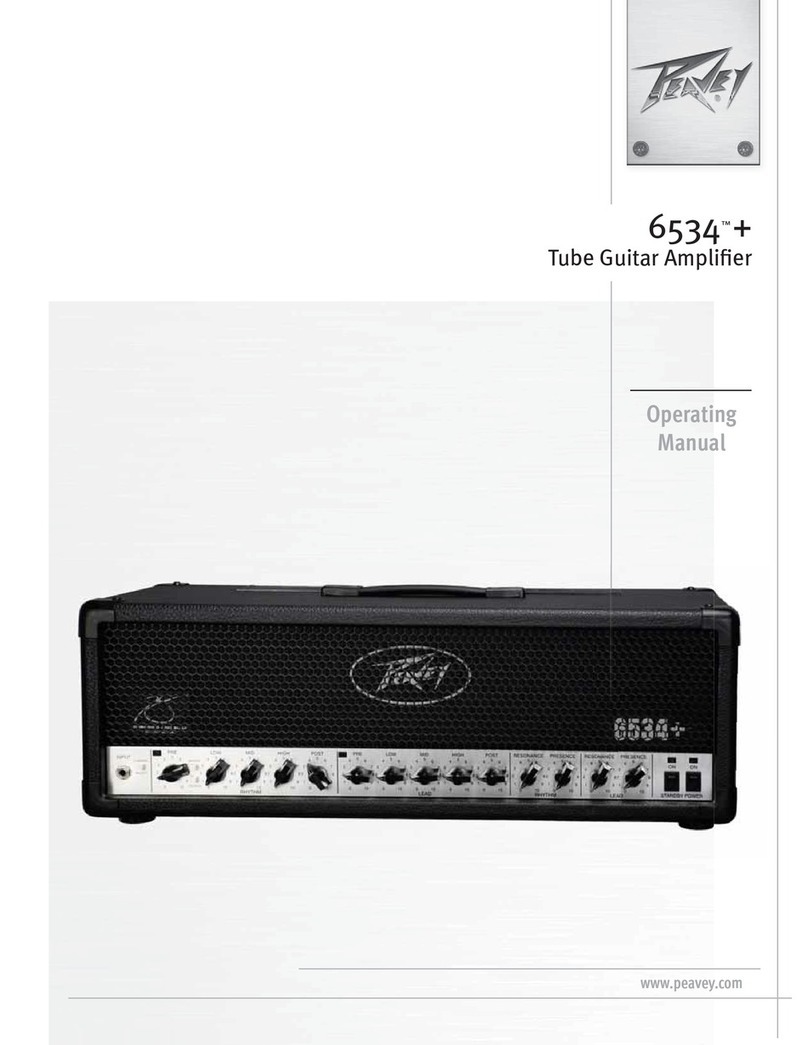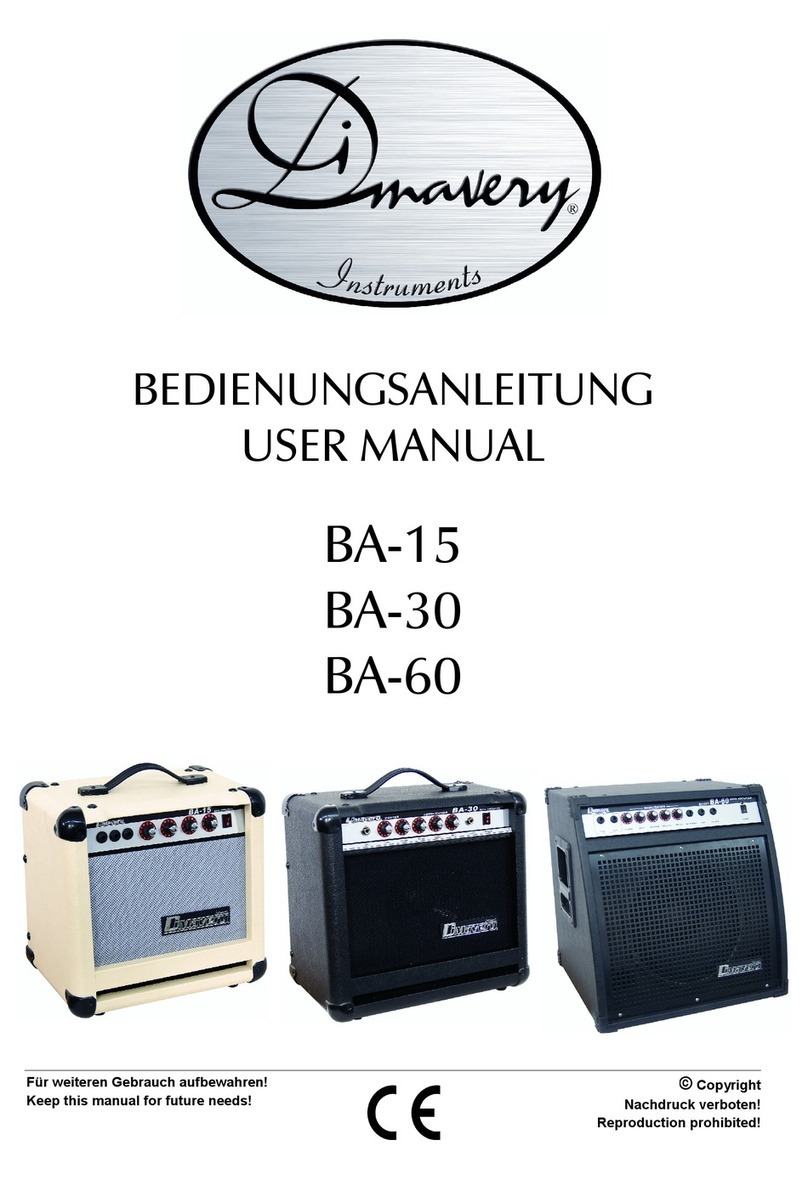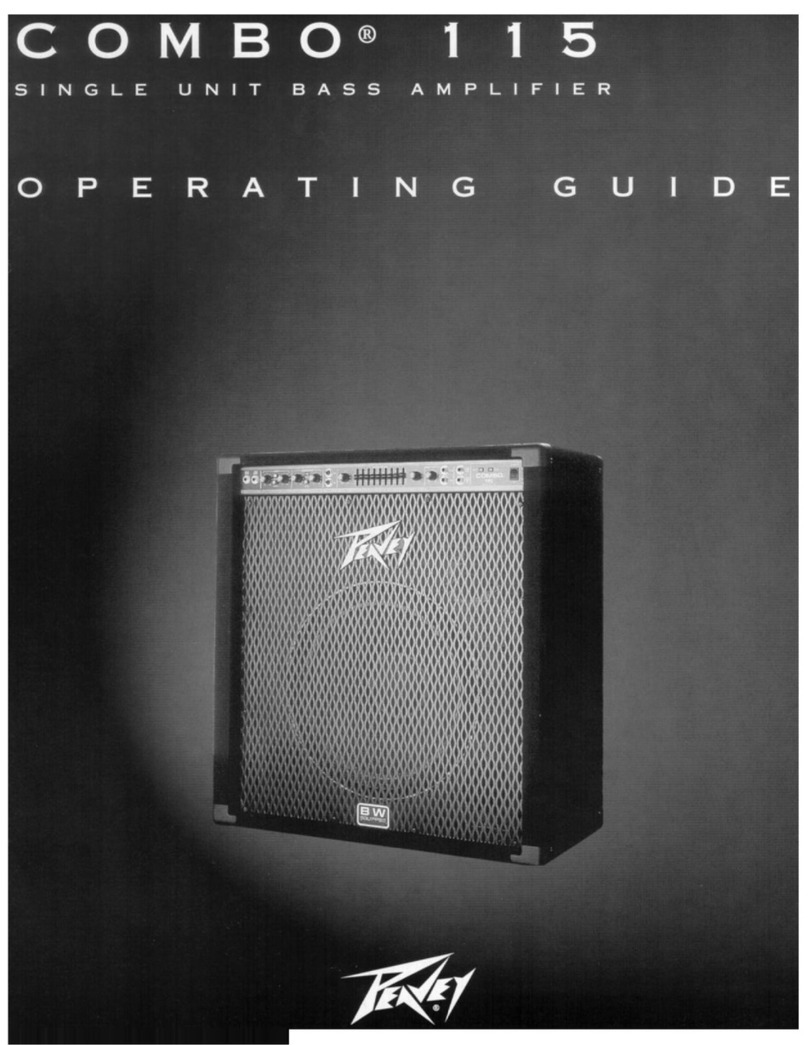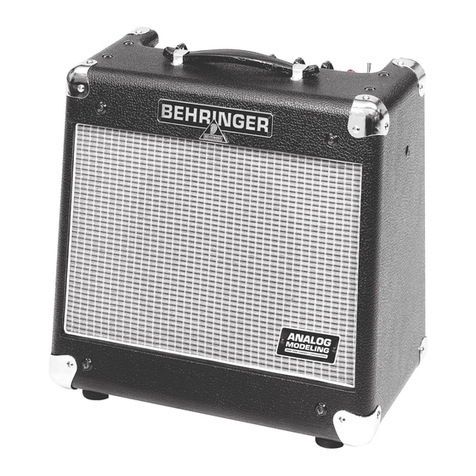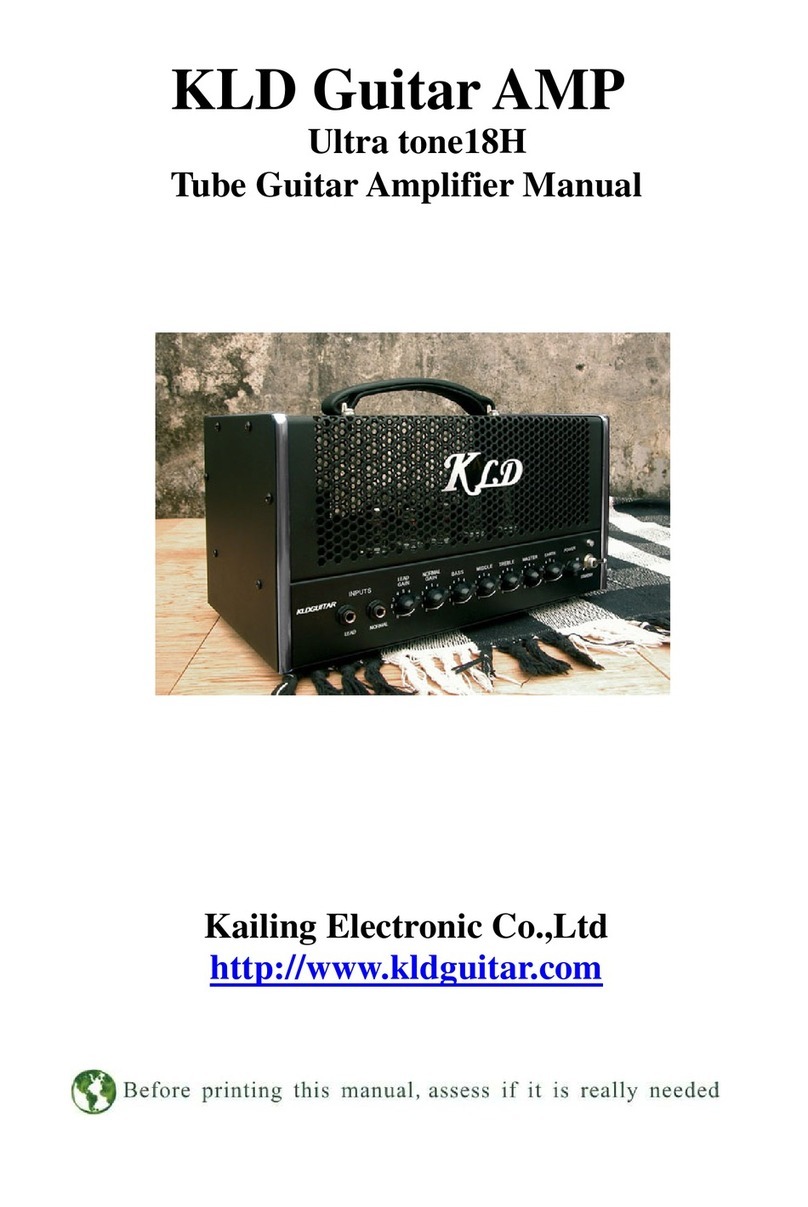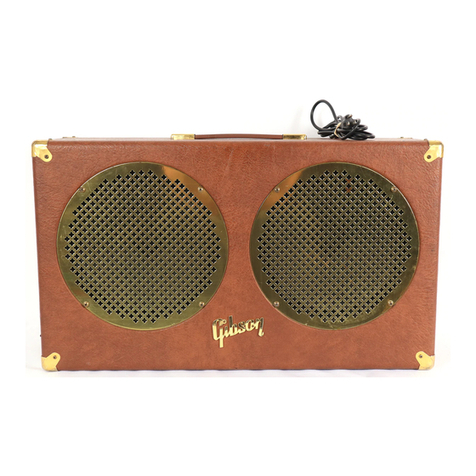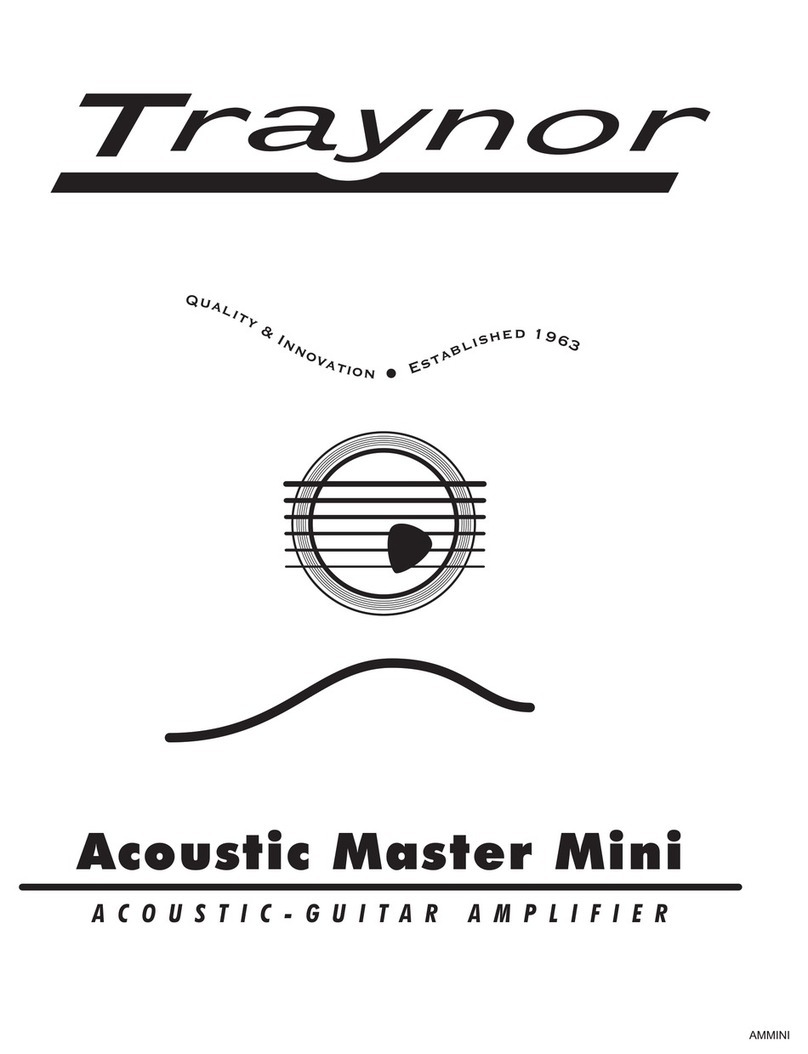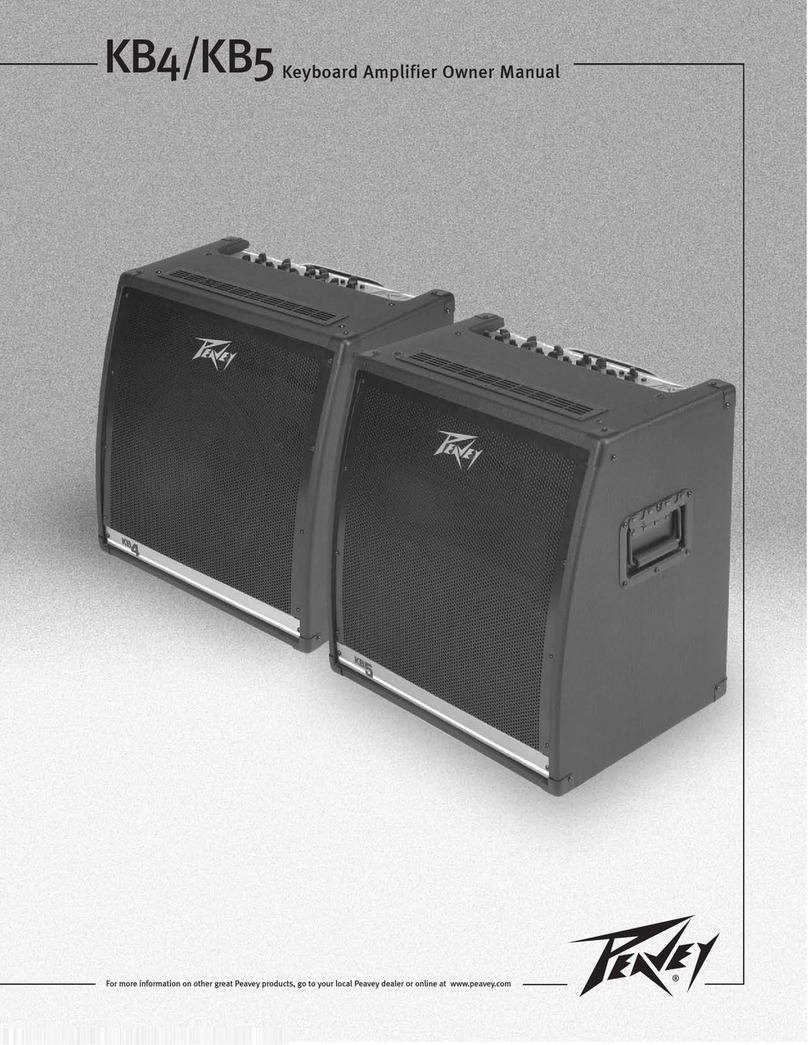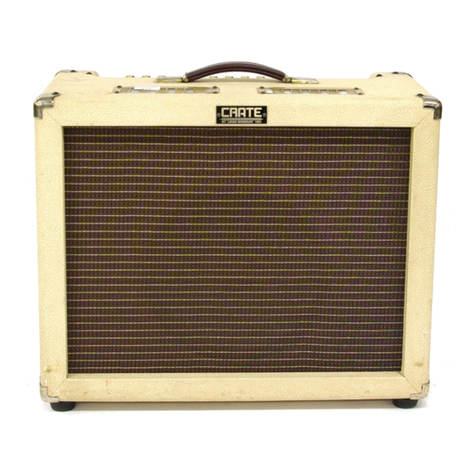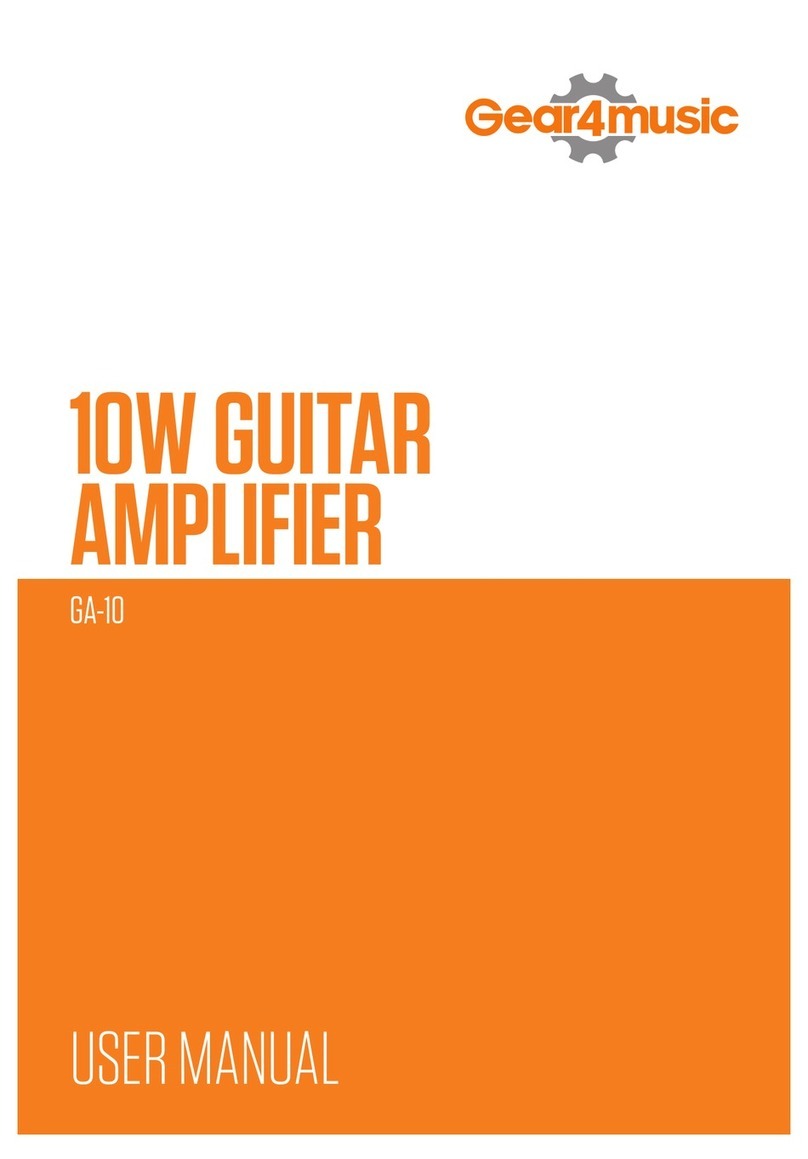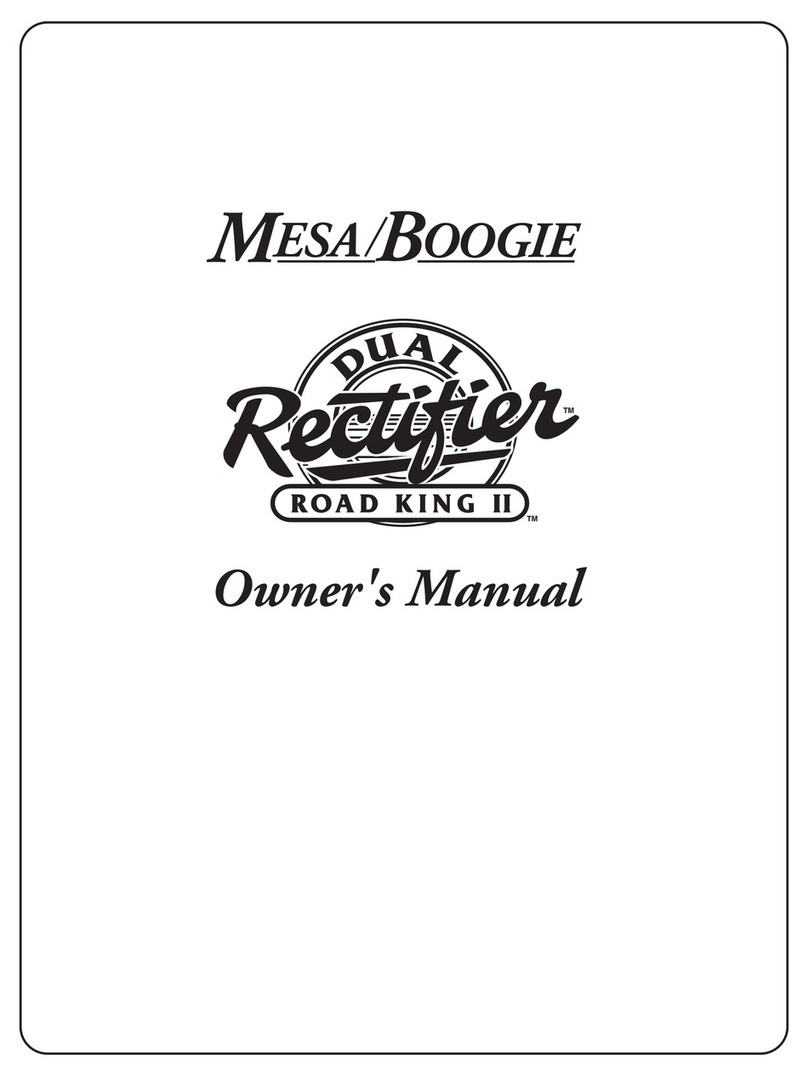Graphtech Ghost User manual

Hexpander MIDI Interface
Be the band.
Acousti-Phonic Pre-amp
User Guide
OVERVIEW OF THE GHOST
®
SYSTEM
Will it work with my guitar?
Introducing modular components
Output options
Mono and Stereo Modes
QuickSwitch functions
Hexpander only and mag-to-pin-7
Sample Control Layouts
PLANNING YOUR GHOST
®
INSTALLATION
Locating Ghost
®
Components
Pots and QuickSwitches
Extension Harness *optional*
Hexpander and 13-pin Jack
Acousti-phonic & 9v battery
Acoustic volume: convert, stack, or drill?
Convert Mag Tone Pot to Acoustic Volume
Replace a Pot with a Stacked Pot
Drill a Hole and Add a Pot
Strats and Teles
Les Pauls and Hollow Bodies
ROUTING, DRILLING, AND NOTCHING
Tools required
Optional Tools
Reversible installation
Saddles
Notching the pick guard or pickup ring
Slotting the base plate *optional*
Drilling between control cavities
Hexpander
13-pin jack
Enlarging the control cavity
Curving the Jack Plate
Acousti-Phonic
Stereo switched Jack (no routing required)
9v battery
INSTALLING GHOST
®
MODULAR COMPONENTS
Saddles
Pickup wires
Color code
Signal/ground color code
Summing board
Extension harness *optional*
Seating and setup
Hexpander
13-pin jack
Connecting the 13-pin jack
Traktion switch
Connecting Pickups to the Hexpander
Program Up/Down (orientation) *optional*
QuickSwitch for MIDI/both/guitar *opt.*
MIDI volume *optional*
Mag-to-pin-7 Harness *optional*
Acousti-Phonic
Acoustic volume and magnetic input
Acoustic volume with Mid/Dark switch *opt.*
Stereo switched output jack
QuickSwitch for mag/both/acoustic *opt.*
Connecting Pickups to the Acousti-phonic
Gain Adjustment
Battery Power
Connecting the Battery
Piggyback – Hexpander + Acousti-Phonic
Other Possible Installations
Dual output jacks
Tone control on piezo
Passive volume kit
TECHNICAL CONSIDERATIONS
Bridge radius - Do not fi le saddles!
Missing Pins (keyed connections)
String ground to prevent hum
Shielded cavity caveat
Ground Loops
Pot & switch mounting hole diameters
2
4
3

The ghost® system is a set of modular components that
adds acoustic or MIDI capability to your guitar without
altering your magnetic pickup tone. Ghost® pickups en-
capsulated in bridge saddles provide the input signal for
the ghost® system, leaving your magnetic pickups un-
changed. You can add either acoustic or MIDI capability or
both, and choose one, a few, or all of the optional controls.
OVERVIEW OF THE GHOST
®
SYSTEM
The ghost
®
system is designed to fi t most gui-
tars and basses. Installing it requires replac-
ing the saddles on your bridge with com-
patible ghost
®
pickup saddles. Graph Tech
makes these for Strat and Tele style guitars,
guitars with Tune-O-matic style bridges
like Gibson and Epiphone, Wilkinson, PRS,
P-bass, Jazz bass,
and any bass that
can accept a Hip-
shot A-style bridge
or ABM saddles.
Floyd Rose Original and Licensed bridges can
be replaced with our pickup-loaded ghost
®
LB63 bridge. Some installations can be
done without altering the instrument at
all, while others will require drilling,
notching, or routing. This depends
on the components you choose, and
the design of your particular instrument.
Will it work with my guitar?
Modular means that the ghost® system’s components can be
plugged into each other in diff erent combinations to create
diff erent systems. Once you’ve selected pickup saddles to fi t
your guitar, these can be connected to the Acousti-Phonic
™
for authentic acoustic sound from your electric guitar, or to
the Hexpander
™
to interface with MIDI and virtual instru-
™ to interface with MIDI and virtual instru-™
ments. Or both the Acousti-Phonic and Hexpander can be
“piggybacked” together. You can add as many or as few of
the optional controls as your instrument will accommodate.
Introducing modular components
Output options
Replacing the 1/4” output jack with the Stereo Switched Jack
supplied with the Acousti-Phonic permits the output of two
signals, magnetic and acoustic, through one jack. The 13-
pin jack installed with the Hexpander carries the hexaphonic
signals for MIDI conversion, and can also carry the magnetic
and acoustic signals so that a 1/4” patch cord is unnecessary.
6
8
5
7

The Acousti-Phonic detects whether you’ve inserted a
stereo or mono plug into the 1/4” jack and automatically
switches to Stereo (separate) or Mono (blended) mode.
Mono and Stereo Modes
In Mono mode, the acoustic and magnetic signals are
blended together in the Acousti-Phonic and delivered to-
gether on the Tip contact. You can plug into one guitar amp
and switch between sounds, or enhance your unaltered
magnetic tone by dialing in a little of the acoustic sound.
In Stereo mode, the acoustic signal is on the Ring con-
tact, and the magnetic signal appears on the Tip con-
tact so that you can process these signals separately
using a stereo-to-two-mono Y-cable. For example, run
your magnetic pickups through a crunchy guitar amp
and your acoustic sound through a clean P.A. system.
Two three-position switches provide fast, intuitive switching
between all possible sound combinations: any one sound,
any combination of two, or all three at the same time. With-
out the switches, you can mute any of the signals by turning
the volume down, but with a QuickSwitch you can instantly
turn a sound off , or on at the volume level you have chosen.
QuickSwitch functions
The QuickSwitches are SPDT on-off -on type switches.They
cannot be replaced with on-on-on type switches or Les Paul
pickup selector switches. QuickSwitches are available from
Graph Tech only in silver color. Note that the Hexpander Quick-
Switch does not control the signals on the Stereo Switched
jack, but does control the three signals on the 13-pin jack.
This option lets you run your acoustic and magnetic sig-
nals down pin number 7 of the 13-pin cable plugged into
the Hexpander, so you don’t need a 1/4” cable attached to
your guitar. Most MIDI converters have two 1/4” outputs
on the back -- one for MIDI and one for this pin-7 signal,
so you can still run your mags to your electric guitar amp.
Hexpander only and mag-to-pin-7
10
12
9
11

When the Hexpander is piggybacked on the Acousti-Phonic,
the mag-to-pin-7 harness is not necessary because Acousti-
phonic passes the acoustic and magnetic signals to the Hex-
pander. But when you install the Hexpander only, adding
the mag-to-pin-7 harness and an acoustic volume control
(250K or 500K audio pot) provides this feature in the absence
of the Acousti-Phonic. Note that the acoustic sound with the
mag-to-pin-7 harness is the raw acoustic sound, and not the
true acoustic sound that the Acousti-Phonic creates. If you
want pin-7 to carry just the mag or just the raw piezo signal,
you can leave the unused wires disconnected and coiled up.
Here are examples of possible control layouts on Strat-
style and Les Paul-style guitars. The ghost® system
is not just for Strats and Les Pauls, and other layouts
are possible, as are custom controls and output op-
tions. Visit www.graphtech.com for more possibilities.
Sample Control Layout(s)
PLANNING YOUR GHOST
®
INSTALLATION
Adding a ghost® system to your instrument begins with
careful planning. Decide which optional controls suit the
music you make, and choose locations that are con-
venient for you. To begin, plug the components into
each other and lay them out on top of the guitar to
decide the location of each component. Look for
space confl icts with adjacent com-
ponents, especially the parts of the
magnetic pickup system already in
your guitar. Make sure that the har-
ness wires are long enough to reach the
location of each component. Remem-
ber that any of the optional controls
can be added to the system later if
you’ve left space for it, but drill-
ing a hole in the wrong place can
be hard to hide. Some routing
may be required to fi t the compo-
nents in your particular instrument.
14
16
13
15

Output Jack Cavity Size
1 1/4”
1”
Edge or Front Mount with jack plate
1-1/8”
1 1/4”
1 1/4”
To locate pots and switches, lay out their fl at washers on
the top of the guitar and arrange them until they look
right, then trace the center of each washer to mark where
to drill the hole. Before you drill, make sure there is room
for the component inside the cavity behind the mark.
Pots and QuickSwitches
The ghost® boards are small -- about the size of a match
box -- so they will fi t inside the control cavity of most
guitars without any routing. You must decide which
arrangement is best for your particular instrument.
Locating Ghost
®
Components
Like an extension cord, it allows you to locate the pickups
further away from the ghost® boards. For some instal-
lations this may be necessary, while for others it may
make the installation neater or more convenient. It can
be used with both the Hexpander and the Acousti-Phonic.
Extension harness *optional*
The 13-pin jack that comes with the Hexpander can be
mounted on the edge, on the front, or on the back of the
instrument. Edge-mounting requires a rectangular hole
and the included 13-pin jack plate, while front and rear
mounting can either use the jack plate or a round hole. The
Hexpander board can be located in the control cavity, but
it must not touch any electrical components or shielding.
Hexpander and 13-pin Jack
Output Jack Hole Size
7/8”
1/16”
5/8”
Rear Mount
The 9v battery that powers the Acousti-Phonic may require
some routing to fi t it inside your guitar. Consider these possible
locations for the battery: the side wall of the cavity, the back
wall behind the pots, or stuck to the control cavity cover plate.
The Hexpander does not require a 9v battery because it will
get power from the MIDI converter through the 13-pin jack.
Acousti-Phonic & 9v battery
18
20
17
19

For the basic installation, convert one of your tone pots into the
acoustic volume using the supplied wiring harness. This avoids
drilling a hole in your guitar to add an acoustic volume pot.
Convert Mag Tone Pot to Acoustic Volume
Acoustic volume: convert, stack, or drill?
The Acousti-Phonic requires a pot to control the level of the acoustic
sound, but none is included. Choose one of these three methods
to add an acoustic volume to your guitar for the ghost® system:
If you prefer to keep your tone control, you can also avoid
drilling a hole for the acoustic volume pot by replacing one
of your pots with a “stacked” or “concentric” pot*. You may
choose to group the magnetic and acoustic volume pots to-
gether on the concentric pot, or group your magnetic volume
and tone on the concentric and convert one of the single pots
into the acoustic volume using the supplied wiring harness.
Replace a Pot with a Stacked Pot
* not sold by Graph Tech -- available from most guitar parts suppliers
If you have room to add another pot to your guitar, you can drill
a hole and add a pot for the acoustic volume. You can purchase
a 250K or 500K audio-taper potentiometer*, or you can get
the ghost® Acoustic Volume with Mid/Dark Switch from Graph
Tech either as a push-on/push-off pot or as a toggle switch.
Drill a Hole and Add a Pot
Strats have the electronics on a front-mounted plastic pick
guard which is easily removed, drilled, notched, and rein-
stalled. The control cavity is also fairly large and can often fi t
the ghost® components without routing. The Strat has two
tone controls, and either one is well suited for conversion to
a ghost® volume. Tele controls are also front mounted, but
the cover plate is metal, and the cavity is quite small; consid-
er adding a 9v battery box* or locating the ghost® boards in
a cavity routed beneath the pick guard or metal bridge plate.
Strats and Teles
Les Paul-style guitars have rear-mounted controls with a
cover-plate, and roomy control cavities. Routing is seldom
required for the Acousti-Phonic. Note that the Les Paul toggle
switch cannot be used as a substitute for the ghost® Quick-
Switch because they make connections diff erently inside.
Hollow bodies have plenty of room to add the ghost® sys-
tem, but it can be diffi cult to work inside them (you may
feel like you’re making a ship in a bottle!) Few of them have
Les Pauls and Hollow Bodies
22
24
21
23

convenient access hatches. If installing the Acousti-Pho-
nic, the board and 9v battery can be located beneath the
magnetic bridge pickup. On some hollow bodies you may
need to rout this cavity deeper to make room. If install-
ing the Hexpander, the board can be inserted through the
hole you make in the edge of the guitar for the 13-pin jack.
ROUTING, DRILLING, AND NOTCHING
Some modifi cation of the guitar body may be required to
install the ghost® system in your instrument. The modi-
fi cation required depends on the design of your instru-
ment, and the ghost® components you’ve chosen to install.
Tools required
Electric drill and 5/16” bit (12” long recommended) for
drilling hole between cavities and starting 13-pin jack hole;
9/32” bit for adding optional pots; 5/64” bit for 13-pin jack
mounting plate holes; and 1/4” bit for installing optional
QuickSwitches
Small round needle fi le for pick guard notches
Screw driver for changing saddles and setting intonation
Phillips screw driver for removing pick guard or cavity cover
Soldering iron (25W) for Acousti-Phonic 1/4” jack and
acoustic volume pot harnesses
Wire stripper / cutter
3/8” chisel for shaping 13-pin jack hole
Olfa or X-Acto knife
masking tape
Optional Tools
Dremel and 1/8” cutting bit for pick guard notches
Router and 3/8” bit for shaping 13-pin jack hole
Optional Tools
Required Tools
Reversible installation
If you have a vintage instrument and its value may be af-
fected by modifi cations, or if you want to try the ghost®
system before committing to the modifi cations re-
quired, you can do a reversible installation. A ghost®
system installed this way may not be as neat or as con-
venient, but you can return the instrument to its origi-
nal condition if you choose to remove the ghost® system.
Strats and Teles: Install the pickups without notching the pick
guard. The pick guard will remain slightly raised over the wires,
and the wires will not be evenly spaced. Or, you can order a
replacement pick guard*, set your original pick guard aside,
and drill and notch the replacement. Converting your tone
control by soldering the supplied wiring harness is reversible.
13-pin jack: mount it in a replacement pick guard or rear
cover plate.
Acoustic Volume: You can omit the volume pot and con-
nect the yellow and purple wires together and operate the
Acousti-Phonic at full volume.
26
28
25
27

The wires on the ghost® saddles must go into the control
cavity to plug into the Hexpander or into the Acousti-Phonic
via the Summing Board and Dual Connector Cable. Cutting
six, small notches beneath the bridge-side of the pick guard
or pickup ring lets the wires enter an existing cavity neatly
and without modifying the body. Notches can be cut with
a Dremel-type rotary tool or by hand with a needle fi le.
Remove the pick guard or pickup ring from the instrument
body for this operation. We recommend removing the pick-
up from the pickup ring to prevent damaging the pickup.
Saddles
Notching the pick guard or pickup ring
Notched
Pick Guard
Notched
Pickup Ring
Slotting the base plate of the bridge is an alternative
to notching the pick guard or pickup ring. It will make
the Ghost® wires practically invisible by running them
into the guitar body through slots cut in the bridge. The
bridge will have to be removed from the guitar and taken
to a machine shop that can cut the slots precisely in the
steel. The diagram below shows the slot dimensions.
Slotting the base plate *optional*
In some installations, you may have to drill a hole to
route the wires between cavities in the instrument to
pass the pickup wires through. This hole will have to
be large enough that the connectors on the pickups
can be passed through easily. We recommend 5/16” di-
ameter. Be careful that the drill chuck does not scrape
the fi nish of the guitar while you are drilling this hole.
Drilling between control cavities
Drill
between
cavities
Do not scratch
guitar with chuck
the fi nish of the guitar while you are drilling this hole.
!
For mounting the Hexpander output on the edge of the in-
strument, the small PC board with the 13-pin jack requires
a rectangular mounting hole in the body. Choose a location
for this hole, checking that there is room for a 1-1/8” (30mm)
deep cavity, and that the ribbon cable will reach from here
to the main Hexpander board. The size and placement of this
hole can be determined using the template in this guide. Cut
out this template and tape it to your guitar where you want
the jack. Follow the 13-pin jack installation instructions
to scribe marks through the template to locate the hole.
Hexpander
13-pin jack
30
32
29
31

The wire colors in this manual are indicated with
the following abbreviations:
Wire Color Abbreviations
Bk = black Gn = green
R = red Bu = blue
O = orange Vi = violet
Y = yellow W = white
Tape the template to the edge of the instrument, and mark
the center of the circles onto the guitar by tapping through
the template into the paint using a center punch and a
small hammer. Using an Olfa or X-Acto knife, slice through
the template along the edges of the inner rectangle, etch-
ing lines in the paint to mark the edges of the mount-
ing hole. Remove the template and make sure these lines
connect in the corners (this prevents your paint from chip-
ping beyond the scratched lines when you begin drilling).
Using a 1/16” bit, drill the four holes for the mounting screws
in the outer most marks to a depth of 1/4”. Make these holes
perpendicular to the surface. Using a 1/8” bit, drill the in-
ner four marks to a depth of 1-1/8”, defi ning the four cor-
ners of the mounting hole. Drill these holes parallel to each
other; in other words don’t drill them perpendicular to the
surface, as this will make the cavity narrower towards the
bottom, preventing the 13-pin board from fi tting properly.
Using a 3/8” bit, drill holes within the inner rect-
angle to remove most of the wood in the cavity.
34
36
33
35

Using a router, a Dremel rotary tool, or a chisel, remove the
remaining wood to edges of the marked rectangle, to a
depth of 1-1/8”. Be careful not to enlarge the mounting hole
beyond the lines, as the jack plate fi ts quite precisely to these
dimensions. Remember, this cavity does not have to be neat
and smooth, as it will be hidden completely by the jack plate.
Drill through the back of this cavity to join it to the
main control cavity where the Hexpander will be lo-
cated. Two 5/16” holes side by side makes a slot
wide enough for the ribbon cable to fi t through.
In most cases, no enlargement of the cavity is required to in-
stall the main Hexpander board. Guitars with small cavities like
Telecasters, or guitars with a lot of electronics already installed
may require some routing to make room for the Hexpander.
Enlarging the control cavity
The jack plate can easily be curved to conform to the surface
of the edge of the instrument where the 13-pin jack is to
be mounted. An even curve can be achieved by placing the
jack plate face up on hard surface with a sharp edge (anvil
or machinist’s vice is ide-
al) and moving the jack
plate progressively over
the edge while tapping
the jack plate against
the edge with a soft-face
mallet. The edge will
make lines on the back
of the jack plate, but
the face will be smooth.
Curving the Jack Plate
Usually, no routing is required to replace the 1/4” jack
in your instrument with the 1/4” Stereo Switched Jack
that comes with the Acousti-Phonic. In some instances,
the jack is recessed in a hole that is too small. In this case
enlarge the recessed hole to 7/8” diameter. The mount-
ing hole for the Stereo Switched Jack is 3/8” diameter.
Acousti-Phonic
Stereo switched Jack (no routing required)
Usually, you can fi nd room for the 9v battery in the existing control
cavity. If your instrument’s cavity is too small or too full of other
electronics, you can either enlarge the cavity or create a cavity
the size and shape of the battery underneath the pick guard.
9v battery
Ghost® saddles are made of our patented String
Saver composite material which is rugged and du-
rable. The pickup wires, however, are delicate
and must be handled gently during installation.
Saddles
INSTALLING GHOST
®
MODULAR COMPONENTS
Route the wires so that they are not fl exed sharply or ex-
cessively, and are not abraded by the edges of holes they
must pass through. When setting the saddle height,
avoid lowering it so much that it crushes the wire or
bends it sharply. On some guitars a neck pocket shim
must be added to maintain suffi cient saddle height.
Pickup Wires
38
40
39

The ghost saddle pickups are all identical and can be in-
stalled in any string position. The ends of the leads are col-
ored as part of quality control testing to balance the out-
puts. If you are installing the Hexpander and you must feed
the wires through a hole from one cavity to another, you
may need to mark the wire ends to be able to tell which is
which. When plugging into the Summing Board for Acousti-
phonic only installations, the pickups can go in any order.
Color code
Use the colored wire on the Extension Harness to make sure
it is oriented properly, extending the pickup wires with-
out reversing them. The blue wires of the pickups must
be connected to the ground side on the ghost® boards.
Extension harness *optional*
The silver wire is signal; the blue wire is ground. If you can’t
tell which is which, try holding the wire at a diff erent angle,
or in a diff erent light.
Signal/ground color code
Connects all the saddle pickup signal wires together,
and all the ground wires together, then the Dual Con-
nector Cable (a small wire with a plug on each end)
connects the Summing Board to the Acousti-Phonic.
Note the Summing Board and Dual Connector Cable
are not used when installing the Hexpander, or when
the Hexpander is piggybacked on the Acousti-phonic.
Summing Board
Ghost® saddles are designed to be set up just like the regu-
lar saddles they replaced. For optimum performance, make
sure that both height adjustment screws are set so that
the saddle pickup is level (Strat, Tele, and PRS), and that
the string is not obstructed in any way as it passes over or
through the saddle. Mechanical interference near the sad-
dle can cause string balance problems or false MIDI trigger-
ing. On ResoMax® bridge installations, adjust the height of
the tail piece so that the strings do not contact the bridge
behind the saddles. The ghost® ResoMax® bridge must be
installed with the intonation screws facing away from the
tail piece or string anchor points. Reversing the bridge will
reduce the string vibration sensed by the saddle pickups.
Seating and setup
Locate the Hexpander where it can accept plug-in connec-
tions from the 13-pin jack, the saddle pickups, and the bat-
tery and options if applicable. When piggybacking with the
Acousti-Phonic, mount the pair of boards on the cavity wall or
rear cover plate using the self-adhesive foam supplied with
the Acousti-Phonic. For Hexpander-only installations, the
Hexpander can be left suspended inside the control cavity, as
the rigidity of the ribbon cable and other wires will stabilize it
suffi ciently. If there is any possibility of the Hexpander coming
into contact with cavity shielding or other electrical compo-
nents, wrap the Hexpander in electrical tape to insulate it, or
add two layers of adhesive foam to the back of the Hexpand-
er board and mount it to the cavity wall or rear cover plate.
Hexpander
42
44
41
43

After the mounting hole has been routed and the 13-pin
jack plate has been curved to conform to the edge of the
guitar (see instructions in the Routing, Drilling, and Notch-
ing section of this manual) bolt the 13-pin jack plate to
the 13-pin jack using the supplied nuts, bolts, and lock
washers. Be careful to align the Traktion switch with the
slot in the 13-pin jack plate; tightening the bolts with
this slot misaligned will damage the Traktion switch and
may make the Hexpander unusable. When tightening the
bolts, make an eff ort to center the 13-pin jack in the round
hole in the 13-pin jack plate. Perfect centering is not nec-
essary, but severe misalignment will prevent the 13-pin
plug from seating properly and making a good connection.
13-pin jack
Align the 13-pin jack plate with the four screw holes
drilled in the guitar body. Make sure that the 13-pin jack
is oriented the same way as planned when making the
mounting hole, as it is not symmetrical and cannot be re-
versed 180 degrees. Attach the 13-pin jack plate to the
guitar body using the four small wood screws supplied.
Plug the Interface Wiring Harness (ribbon cable)
into the header pins on 13-pin jack; this connec-
tion is ‘keyed’ (one pin missing, one hole blocked)
so that it can only be plugged in correctly. Feed the
harness through the mounting hole and into the
control cavity where the Hexpander will be located.
Connecting Hexpander to 13-pin jack
The Traktion Switch optimizes the output of the Hexpander
for use with either Roland or Axon MIDI converters. Reach
into the slot on the 13-pin jack plate with a toothpick to
slide this tiny switch to
match the converter you’re
using. If your converter is a
Yamaha or another brand,
try both positions and use
the one that works best.
Traktion Switch
Plug the six blue and silver wires from the pickups into the
Hexpander on the pin pairs labeled 1, 2, 3, 4, 5, 6, with the
silver wires nearest the labels and the blue wires on the
ground row, according to the order for your instrument:
Connecting Pickups to the Hexpander
6 string guitar EBGDAE = 123456
4 string bass GDAE = 2345
5 string bass GDEAB = 23456
6 string bass CGDAEB = 123456
46

HEXPANDER CONNECTION DIAGRAM
Drill a 1/4” hole in the pick guard or guitar top and mount
the switch using the nuts and washers supplied. Orient the
switch as desired: pushing the toggle towards the violet
wire scrolls up, and towards the yellow wire scrolls down.
Plug the connector into the Hexpander on the rows marked
S1 and S2 with only the black wire on the ground row.
Program Up/Down Switch *optional*
Drill a 1/4” hole in the pick guard or guitar top and mount the
QuickSwitch using the nuts and washers supplied. Orient the
switch according to your preference, using the colors of the
wires soldered onto the switch to indicate which direction is
which. Plug the QuickSwitch into the second row of the Hex-
pander on the pins marked VI and VO to select MIDI/both/guitar.
QuickSwitch for MIDI/both/guitar *optional*
50
49
51
48

Use an existing hole, or drill a new 9/32” hole in the pick guard
or guitar top and mount the pot using the nuts and washers
supplied. Plug the MIDI volume pot connector (red, white, and
black wires) into the Hexpander on the rows marked VO and VI.
MIDI volume pot *optional*
Note: a 250k linear-taper pot is preferred, but it will work with
a 250K audio-taper pot too. (regular guitar pots are audio-
taper) You will still be able to control MIDI volume if you use
an audio-taper pot, but mid-volume will not be at mid-scale.
Plug the Mag-to-pin-7 harness into the fi rst row of the
Hexpander, nearest the edge of the board. It will span
the pins labeled PMGVM, with the colored wires near-
est the labels and the black wires on the ground row.
Mag-to-pin-7 Harness *optional*
Locate the Acousti-Phonic where it can accept plug-in
connections from the 1/4” jack, the saddle pickups, the
battery, and options if applicable. Attach it, using the
self adhesive foam tape on the back, to the side or back
of the control cavity or to the inside of the cover plate.
Acousti-Phonic
Acoustic volume and magnetic input
The Basic Acousti-Phonic does not include a volume pot, but
instead a wiring harness is provided to convert one of your
tone controls into the Acoustic Volume Pot. (The Advanced
Kit includes the Acoustic Volume with Mid/Dark Switch
complete with harness, or you can order it as a separate
item) The pot you convert should be either 250k or 500k to
work properly with the Acousti-Phonic. (If you would like
to operate the Acousti-Phonic without a volume pot, you
can install the wiring harness only and get acoustic output
always at full volume. Solder the purple and yellow wires
together, and coil up the black wire and leave it unused.)
To convert your tone control to an acoustic volume control,
begin by unsoldering and removing any wires or compo-
nents attached to the tone pot. Solder the purple, yellow,
and black wires to the pot according to the diagram. Plug
the acoustic volume harness into the Acousti-Phonic so that
it spans the pin rows labeled GST VOL MAG (G V M when the
Hexpander is piggybacked on the Acousti-Phonic) with the
purple, yellow, and green wires nearest the labels and the
ground wire furthest from the labels. The green wire is the
input from your magnetic pickups; solder it to the middle
lug of your magnetic volume pot. Remove the wire that
runs from your 1/4” jack to the magnetic pickup system.
54
53
55
52

Acoustic volume with Mid/Dark switch
*optional*
This switch selects either the EQ’d ghost® acoustic sound,
or a second EQ curve with a boost in the mid range. It
can be installed either as a mini-toggle switch, or as a
switch incorporated in a pot. A push-on/push-off pot is
available as part of the ghost® system, which controls
acoustic volume and the Mid/Dark switching, or we can
provide the harness with a mini-toggle switch for you
to convert one of your tone pots. The green wire is the in-
put from your magnetic pickups; solder it to the middle
lug of your magnetic volume pot. Unsolder the wire that
runs from your 1/4” jack to the magnetic pickup system.
Solder the Output Jack Harness (red, white, blue, two
blacks) to the supplied Stereo Switched Output Jack, cut-
ting the wires to a reasonable length for your installa-
tion. The second black wire can go to the same lug as
the fi rst, or be used as a bridge ground if necessary. Re-
move the guitar’s 1/4” jack and replace it with the Ste-
reo Switched Jack, using the nuts and washers supplied.
Stereo Switched Output Jack
Black goes to the sleeve contact, Red to the Ring, Blue to
the Tip, and White to the Switch contact, which shorts to
the Tip contact when the plug is withdrawn from the 1/4”
jack. When the plug is inserted in the jack, these contacts
separate, and power is supplied to the Acousti-Phonic and
any other device powered by the red Auxiliary Power lead.
Drill a 1/4” hole in the pick guard or guitar top and mount
the QuickSwitch using the nuts and washers supplied. Ori-
ent the switch according to your preference, using the col-
ors of the wires soldered onto the switch to indicate which
direction is which. Plug the QuickSwitch into the Acousti-
Phonic (or on the pass-through pins marked Q Q in the
piggyback confi guration) to select mag/both/acoustic.
QuickSwitch for mag/both/acoustic
*optional*
The Acousti-Phonic has a blue and white trim pot that can
be adjusted with a small screw driver to match the level of
the acoustic output to
the level of the magnetic
pickups. Clockwise in-
creases the gain. Turning
it all the way counter-
clockwise does not turn
the acoustic signal to zero.
Gain Adjustment
ACOUSTIC GAIN
ADJUSTMENT
PIGGYBACK
CONNECTOR
Plug the six blue and silver wires from the pickups into
the Summing Board with all the blue wires on the same
side and all the silver wires on the other. Plug the Dual
Connector Cable into the Acousti-Phonic on the pins
marked Pin (Pickup In) with the brown wire on ground,
away from the label. Plug the other end of the Dual
Connector Cable into the Summing Board with the
brown wire on the same side as the blue pickup wires,
and the grey wire on the same side as the silver wires.
Connecting Pickups to Acousti-Phonic
58
57
56

A battery is required to power the Acousti-Phonic. The
magnetic signal has to go through the Acousti-Phonic for
blending purposes, so if the battery is removed or dead,
there will be no output from the 1/4” jack, not even mag-
netic pickups. In normal use this battery lasts 500 hours,
which means changing it twice a year will ensure that it
never goes dead. Always unplug the cable from the 1/4”
jack to conserve battery life when not using the guitar.
Connect the Battery Clip Harness (red, black, a short
red) to the battery and insert the battery into the metal
holder. Locate the battery along the side or back wall of
the control cavity, or on the cavity cover plate. Make sure
the wiring harness will reach the Acousti-Phonic, then
peel and stick the Battery Holder to the chosen location.
The Acousti-Phonic is designed to operate on 9v or 18v, and
the same batteries that power it can also power active pickups
or another on-board device by using the short, red Auxiliary
Power Lead. Ground the active magnetic pickups using any of
Battery Power
the black ground wires on the harnesses. These ground wires
will all be lifted from the battery negative when the 1/4” plug
is removed from the Stereo Switched Jack, powering off both
the Acousti-Phonic and the active pickups or other accessory.
Plug in the battery harness last, and make abso-
lutely certain that the black wire is alone on the
ground row of pins, and the two red wires are on
the row with the other colored wires. Plugging
this in incorrectly may damage the ghost® boards.
The battery harness connector spans the two pin
rows labeled PWR (power) and BAT (battery).
Connecting battery to Acousti-Phonic
ACOUSTI-PHONIC CONNECTION DIAGRAM
61
63
62

When installing both boards, connect them together
with the Acousti-Phonic on top and Hexpander on the
bottom. Plug the row of pins on the Acousti-Phonic
into the matching receptacle on the bottom of the Hex-
pander. The boards will align, and the blue and white
screwdriver adjustment on the Acousti-Phonic will be
accessible through the hole in the Hexpander board.
Piggyback -- Hexpander + Acousti-Phonic
You can have two 1/4” output jacks on your guitar with mag-
netic on one, and acoustic on the other. The Acousti-Phonic’s
mono (blended) mode does not function in this confi gura-
tion, as the magnetic pickups do not go through the Acous-
ti-Phonic. Visit www.graphtech.com for wiring diagrams.
Dual output jacks
The ghost® system is quite versatile, and the instal-
lation described in this manual is by no means the
only possibility. Included below are a few of the most
popular alternatives to the standard installation.
Other Possible Installations
You can add a tone control to the Acousti-Phonic volume circuit to
attenuate the high frequencies, the same as you would on your
magnetic circuit. Be forewarned that a lot of players think they
will need this, but discover they never use it because they prefer
the EQ’d acoustic sound the way it is. Try your ghost® system fi rst
without the added tone pot, and install it if you really need it.
Tone control on acoustic
This kit is for connecting the ghost® pickups to an output jack
without the Acousti-Phonic. It provides an on-board acous-
tic volume control, and prevents loss of high frequencies at
lower volumes. The 5M volume pot included in the kit helps
match the high-impedance ghost® pickups to a standard
amp input. Without the Acousti-Phonic, the output of the
pickups is rather harsh, and does not sound like an acous-
tic guitar, so we recommend that you process the passive
signal external to the guitar using a preamp or active EQ.
Passive volume kit
* not sold by Graph Tech -- available from most guitar parts suppliers
The bridge radius should match the fi ngerboard radius in
order to prevent “fretting out” -- fret buzz or wrong notes
sounding when you play high up the neck. The ResoMax®
bridge assembly is
manufactured with
a fi xed radius of 12”.
Do not fi le ghost®
pickup saddles
to adjust the ra-
dius, as this will change the output levels unpredict-
ably. The LB63 has a radius of 20”, and this can be ad-
justed by inserting shims* under saddles that are too low.
Bridge radius - Do not fi le saddles!
Technical Considerations
66
65
67
64

To prevent critical connections from being plugged in
the wrong way, some pins have been clipped on the Hex-
pander, the 13-pin Jack board, and the Acousti-Phonic.
Corresponding holes are blocked on the plug-in connec-
tors so that they can only go together correctly. In this
diagram, the black squares indicate pins that are missing.
Missing Pins (keyed connections)
Acousti-phonic
Hexpander
Because ghost® saddles are non-conductive, on some
guitars this can isolate the strings from the grounded
bridge and cause them to pick up hum. This often needs
to be addressed on Les Pauls and other guitars with
Tune-O-Matic style bridges, including ResoMax® bridges.
To ground the strings, run a ground wire to the post of
the tail piece, or other string anchor point. On guitars
where the strings are anchored in metal ferrules pressed
into the wood, each ferrule must be grounded individu-
ally. This may take some creativity and skill to do invisibly.
String ground to prevent hum
Ground loops cause your guitar to pick up annoying hum or
buzz (sometimes even radio stations!) and can be diffi cult to
troubleshoot. The best strategy is to choose a central ground
point (usually the back of one of the pots) and make all oth-
er ground wires join here in a star pattern. Avoid creating
loops; in other words, don’t run a ground wire from the fi rst
component, to the second, to the third, and back to the fi rst.
Ground Loops
Sometimes a loop can be formed accidentally, through cavity
shielding or another conductive component. If you’re experienc-
ing problems, “think like an electron” and see if there’s more than
one way to get back to ‘true ground’. If you fi nd several paths,
eliminate them until there is only one wire to take you home.
Pot & switch mounting hole diameters
Pots 9/32”
QuickSwitches 1/4”
Stereo Switched Jack 3/8” (recess in 7/8” hole if necessary)
70
69
71
68

Shielded cavity caveat
To improve noise immunity, the walls of the control cavity
are sometimes shielded, either with metal foil or conduc-
tive paint (usually grey or black). This conductive shield-
ing can sometimes cause problems for the ghost® system.
The ghost® boards are not coated or insulated, so they
must not touch the cavity shielding. Mounting the boards
on the shielding is okay, as long as the foam tape on the
back of the Acousti-phonic board keeps the board sepa-
rated from the shielding. If you fi nd it diffi cult to install
the ghost® boards with space around them to prevent
touching the shielding, after you’ve plugged in the pick-
ups and all other connections, wrap the board(s) in electri-
cian’s tape to insulate the board from the cavity shielding.
In some instances, the cavity shielding can ironically cause
the ghost® system to pick up “buzz” or “hum” (sometimes
even radio stations)! Because it is a modular system, each
ghost® component comes with a ground wire. This abun-
dance of ground wires, combined with the pots and switch-
es being grounded through the shielding where they are
mounted, increases the likelihood of creating a ground loop.
INSTALLATION NOTES
www.graphtech.com
sales@graphtech.com
73
Other manuals for Ghost
1
Table of contents

